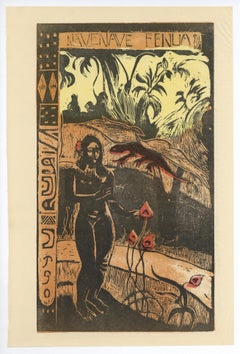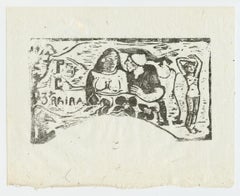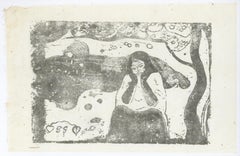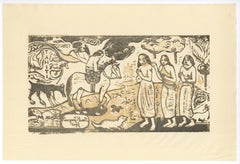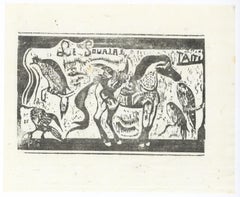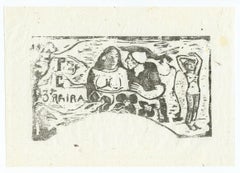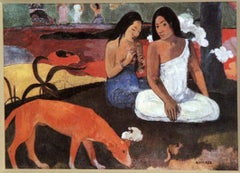(after) Paul Gauguin Art
to
11
2
10
3
10
1
2
Overall Height
to
Overall Width
to
13
8
6
6
4
3
2
2
1
1
1
1
1
1
1
1
1
13
1
10
1
1
13
6,891
3,229
2,514
1,217
13
Artist: (after) Paul Gauguin
Auti Te Pape
By (after) Paul Gauguin
Located in Henderson, NV
The English title is "Women at the River". This impression (after the original woodcut) was printed on japon paper in 1943 in an edition of 250, and is one of Gauguin's beautiful Tah...
Category
1940s Post-Impressionist (after) Paul Gauguin Art
Materials
Lithograph
Nave Nave Fenua
By (after) Paul Gauguin
Located in Henderson, NV
The English title is "Delicious Earth". This impression (after the original woodcut) was printed on japon paper in 1943 in an edition of 250, and is one of Gauguin's beautiful Tahiti...
Category
1940s Post-Impressionist (after) Paul Gauguin Art
Materials
Lithograph
Le Sourire 1
By (after) Paul Gauguin
Located in Henderson, NV
This impression (after the original woodcut) was printed on japon paper in 1943 in an edition of 250, and is one of Gauguin's beautiful Tahiti compositions. Image size: 4 1/4 x 7 1/4...
Category
1940s Post-Impressionist (after) Paul Gauguin Art
Materials
Lithograph
Miseres Humaines, souvenir de Bretagne
By (after) Paul Gauguin
Located in Henderson, NV
This impression (after the original woodcut) was printed on japon paper in 1943 in an edition of 250, and is one of Gauguin's beautiful Tahiti compositions. Image size: 7 3/4 x 11 3/...
Category
1940s Post-Impressionist (after) Paul Gauguin Art
Materials
Lithograph
Changement de residence
By (after) Paul Gauguin
Located in Henderson, NV
This impression (after the original woodcut) was printed on japon paper in 1943 in an edition of 250, and is one of Gauguin's beautiful Tahiti compositions. Image size: 6 1/4 x 12 in...
Category
1940s Post-Impressionist (after) Paul Gauguin Art
Materials
Lithograph
Le Sourire 2
By (after) Paul Gauguin
Located in Henderson, NV
This impression (after the original woodcut) was printed on japon paper in 1943 in an edition of 250, and is one of Gauguin's beautiful Tahiti compositions. Image size: 5 1/2 x 8 3/4...
Category
1940s Post-Impressionist (after) Paul Gauguin Art
Materials
Lithograph
Te Arii Vahine
By (after) Paul Gauguin
Located in Henderson, NV
The English title is "Woman of Royal Blood". This impression (after the original woodcut) was printed on japon paper in 1943 in an edition of 250, and is one of Gauguin's beautiful T...
Category
1940s Post-Impressionist (after) Paul Gauguin Art
Materials
Lithograph
Le Sourire 3
By (after) Paul Gauguin
Located in Henderson, NV
This impression (after the original woodcut) was printed on japon paper in 1943 in an edition of 250, and is one of Gauguin's beautiful Tahiti compositions. Image size: 4 x 7 1/4 inc...
Category
1940s Post-Impressionist (after) Paul Gauguin Art
Materials
Lithograph
Soyez amoureuses, vous serez heureuses
By (after) Paul Gauguin
Located in Henderson, NV
The English title is "Be in Love and You Will Be Happy". This impression (after the original woodcut) was printed on japon paper in 1943 in an edition of 250, and is one of Gauguin's...
Category
1940s Post-Impressionist (after) Paul Gauguin Art
Materials
Lithograph
Le Porteur de Fei
By (after) Paul Gauguin
Located in Henderson, NV
This impression (after the original woodcut) was printed on japon paper in 1943 in an edition of 250, and is one of Gauguin's beautiful Tahiti compositions. Image size: 6 1/2 x 11 in...
Category
1940s Post-Impressionist (after) Paul Gauguin Art
Materials
Lithograph
The White Horse - Lithograph - Numbered / 250
By (after) Paul Gauguin
Located in Paris, FR
Paul GAUGUIN (after)
The White Horse
Stone lithograph after a painting
Printed signature in the plate
Numbered /250 copies
On vellum 76 x 56 cm (c. 30 x 22 in)
Information : This l...
Category
1970s Post-Impressionist (after) Paul Gauguin Art
Materials
Lithograph
Still Life with Mandolin - Pochoir - Spitzer edition circa 1950 /250ex
By (after) Paul Gauguin
Located in Paris, FR
Paul GAUGUIN (after)
Still life with Mandolin
Lithograph and pochoir (Spitzer process)
Printed signature in the plate
Numbered / 250
Blind s...
Category
1950s Fauvist (after) Paul Gauguin Art
Materials
Lithograph
Joies de Bretagne
By (after) Paul Gauguin
Located in Missouri, MO
Paul Gauguin (1848-1903)
Joies de Bretagne (Kornfeld 7 B)
zincograph, 1889, on simili Japon paper, from the second edition of circa 50 impressions, published by Ambroise Vollard afte...
Category
Early 1900s Fauvist (after) Paul Gauguin Art
Materials
Lithograph
Related Items
Ambassadeurs Aristide Bruant in his cabaret by Henri de Toulouse-Lautrec
By (After) Henri Toulouse Lautrec
Located in New York, NY
This lithographic poster illustrates Aristide Bruant who was a famous performer and cabaret owner in Paris at the turn of the 20th century. Lautrec, seizing on Bruant's trademark cos...
Category
Late 19th Century Post-Impressionist (after) Paul Gauguin Art
Materials
Lithograph
Henri Matisse – Le Repos du modèle - hand-signed lithograph - 1922
By Henri Matisse
Located in Varese, IT
HENRI MATISSE (1869-1954)
Le Repos du modèle
lithograph, on Japanese paper, 1922, Duthuit’s first state (of two), signed in pencil by artist, one of 85 signed impressions from a plan...
Category
1920s Post-Impressionist (after) Paul Gauguin Art
Materials
Lithograph, Paper
Pierre Bonnard ltd edition Lithograph Printed at Mourlot Paris 1958 Chicken, Egg
By Pierre Bonnard
Located in Surfside, FL
This is from a limited edition portfolio of original lithographs print Fernand Mourlot in Paris in 1958 from work done in collaboration with Bonnard which began in 1928.
This is from the rare first edition, No. VII of 20 unbound sets, specially printed for Hans P. Kraus, with Henry de Montherlant inscription to him signed and dated March 3, 1960
These are not individually hand signed or numbered.
On BFK Rives French velin art paper
Pierre Bonnard (1867 – 1947) was a French painter, illustrator and printmaker, known especially for the stylized decorative qualities of his paintings and his bold use of color. A founding member of the Post-Impressionist group of avant-garde painters Les Nabis, (the Naive artists) his early work was strongly influenced by the work of Paul Gauguin, as well as the prints of Hokusai and other Japanese artists. Bonnard was a leading figure in the transition from Impressionism to Modernism. He painted landscapes, urban scenes, portraits and intimate domestic scenes, where the backgrounds, colors and painting style usually took precedence over the subject.
Pierre Bonnard was born in Fontenay-aux-Roses, Hauts-de-Seine on 3 October 1867. His mother, Élisabeth Metzdorff, was from Alsace. His father, Eugène Bonnard, was from the Dauphiné, and was a senior official in the French Ministry of War. He had a brother, Charles, and a sister, Andrée, who in 1890 married the composer Claude Terrasse.
He received his education in the Lycée Louis-le-Grand and Lycée Charlemagne in Vanves. He showed a talent for drawing and water colors, as well as caricatures. He painted frequently in the gardens of his parent's country home at Grand-Lemps near the Cote Saint-André in the Dauphiné. He also showed a strong interest in literature. He received his baccalaureate in the classics, and, to satisfy his father, between 1886 and 1887 earned his license in law, and began practicing as a lawyer beginning in 1888. While he was studying law, he also attended art classes at the Académie Julian in Paris. At the Académie Julien he met his future friends and fellow artists, Paul Sérusier, Maurice Denis, Gabriel Ibels and Paul Ranson. In 1888 Bonnard was accepted by the École des Beaux-Arts, where he met Édouard Vuillard and Ker Xavier Roussel. He also sold his first commercial work of art, a design for poster for France-Champagne, which helped him convince his family that he could make a living as an artist. He set up his first studio at on rue Lechapelais and began his career as an artist.
From 1893 until her death, Bonnard lived with Marthe de Méligny (1869–1942), and she was the model for many of his paintings, including many nude works. Her birth name was Maria Boursin, but she had changed it before she met Bonnard. They married in 1925. In the years before their marriage, Bonnard had love affairs with two other women, who also served as models for some of his paintings, Renée Monchaty (the partner of the American painter Harry Lachmann) and Lucienne Dupuy de Frenelle, the wife of a doctor; it has been suggested that Bonnard may have been the father of Lucienne's second son. Renée Monchaty committed suicide shortly after Bonnard and de Méligny married.
In 1891 he met Toulouse-Lautrec and in December 1891 showed his work at the annual exhibition of the Société des Artistes Indépendants. In the same year Bonnard also began an association with La Revue Blanche, for which he and Edouard Vuillard designed frontispiece In March 1891, his work was displayed with the work of the other Nabis at the Le Barc de Boutteville. The style of Japanese graphic arts became an important influence on Bonnard. In 1893 a major exposition of works of Utamaro and Hiroshige was held at the Durand-Rouel Gallery, and the Japanese influence, particularly the use of multiple points of view, and the use of bold geometric patterns in clothing, such as checkered blouses, began to appear in his work. Because of his passion for Japanese art, his nickname among the Nabis became Le Nabi le trés japonard. He devoted an increasing amount of attention to decorative art, designing furniture, fabrics, fans and other objects. He continued to design posters for France-Champagne, which gained him an audience outside the art world. In 1892 he began to produce lithographs, and painted two of his early notable works, Le Corsage a carreaux and La Partie de croquet. He also made a series of illustrations for the music books of his brother-in-law, Claude Terrasse. In 1895 he became an early participant of the movement of Art Nouveau, designing a stained glass window, called Maternity, for Tiffany. In 1895 he had his first individual exposition of paintings, posters and lithographs at the Durand-Ruel Gallery. He also illustrated a novel, Marie, by Peter Nansen, published in series by in La Revue Blanche. The following year he participated in a group exposition of Nabis at the Ambroise Vollard Gallery. In 1899, he took part in another major exposition of works of the Nabis.
Throughout the early 20th century, as artistic styles appeared and disappeared with almost dizzying speed, Bonnard kept refining and revising his personal style, and exploring new subjects and media, but keeping the distinct characteristics of his work. Working in his studio at 65 rue de Douai in Paris, he presented paintings at the Salon des Independents in 1900, and also made 109 lithographs for Parallèment, a book of poems by Verlaine. He also took part in an exhibition with the other Nabis at the Bernheim Jeune gallery. He presented nine paintings at the Salon des Independents in 1901. In 1905 he produced a series of nudes and of portraits, and in 1906 had a personal exposition at the Bernheim-Jeune Gallery. In 1908 he illustrated a book of poetry by Octave Mirbeau, and made his first long stay in the South of France, at the home of the painter Manguin in Saint-Tropez. in 1909, and in 1911 began a series of decorative panels, called Méditerranée, for the Russian art patron Ivan Morozov.
During the years of the First World War, Bonnard concentrated on nudes and portraits, and in 1916 completed a series of large compositions, including La Pastorale, Méditterranée, La Paradis Terreste and Paysage de Ville. His reputation in the French art establishment was secure; in 1918 he was selected, along with Renoir, as an honorary President of the Association of Young French Artists. In the 1920s, he produced illustrations for a book by Andre Gide (1924) and another by Claude Anet (1923). He showed works at the Autumn Salon in 1923, and in 1924 was honored with a retrospective of sixty-eight of his works at the Galerie Druet. In 1925 he purchased a villa in Cannes.
In 1938 his works and Vuillard were featured at an exposition at the Art Institute of Chicago. The outbreak of World War II in September 1939, forced Bonnard to depart Paris for the south of France, where he remained until the end of the war. Under the German occupation, he refused to paint an official portrait of the French collaborationist leader, Marechal Petain, but accepted a commission to paint a religious painting of Saint Francis de Sales, with the face of his friend Vuillard, who had died two years earlier. He finished his last painting, The Almond Tree in Blossom, a week before his death in his cottage on La Route de Serra Capoue near Le Cannet, on the French Riviera, in 1947. The Museum of Modern Art in New York City organized a posthumous retrospective of Bonnard's work in 1948, although originally it was meant to be a celebration of the artist's 80th birthday.
Bonnard particularly used the model of Japanese art in a series...
Category
20th Century Post-Impressionist (after) Paul Gauguin Art
Materials
Lithograph
LOWEST $ DIB Post Impressionist “LE HAVRE” Lithograph 1930 Figures and Seascrape
By Raoul Dufy
Located in New York, NY
Here I have the lowest authentic priced Raphl Dufy Le Havre for sale!
Originally purchased purchased from Sotheby’s
I’m 1984 for approx $3500, I have attached a photo of receipt ...
Category
1930s Post-Impressionist (after) Paul Gauguin Art
Materials
Lithograph
Maisons sur la Rivière, Canal à Nemours (Houses on the River, Nemours Canal)
By Henri Le Sidaner
Located in Saint Augustine, FL
Artist: Henri Le Sidaner (French, 1862-1939)
Title: "Maisons sur la Rivière, Canal à Nemours (Houses on the River, Nemours Canal)"
Portfolio: Revue de l'Art Ancien & Moderne
*Issued ...
Category
1920s Post-Impressionist (after) Paul Gauguin Art
Materials
Lithograph
La Balustrade (The Railing) /// Impressionist Henri Le Sidaner Landscape Garden
By Henri Le Sidaner
Located in Saint Augustine, FL
Artist: Henri Le Sidaner (French, 1862-1939)
Title: "La Balustrade (The Railing)"
Portfolio: Gazette des Beaux-Arts
*Issued unsigned, though signed by Sidaner in the plate (printed s...
Category
1910s Post-Impressionist (after) Paul Gauguin Art
Materials
Lithograph
Quai Boïeldieu, à Rouen by Camille Pissarro - Landscape lithograph
By Camille Pissarro
Located in London, GB
Quai Boïeldieu, à Rouen by Camille Pissarro (1830-1903)
Lithograph
27.7 x 36 cm (10 ⁷/₈ x 14 ¹/₈ inches)
Stamped lower left and numbered lower right, 8/14
Executed circa 1896
Delteil...
Category
1890s Post-Impressionist (after) Paul Gauguin Art
Materials
Lithograph
Le Nu Aux Oranges - Color Lithograph - 2007 - Henri Matisse
By (after) Henri Matisse
Located in Sint-Truiden, BE
Color lithograph after the work by Henri Matisse, plate-signed by Matisse from the edition of 200.
This lithograph was printed and published in 2007 in Paris using 100% cotton 300 g...
Category
Early 2000s Fauvist (after) Paul Gauguin Art
Materials
Lithograph, Handmade Paper
Paris School Minaux Matisse Post-Impressionist Still Life Lithograph Flowers
By Andre Minaux
Located in Norfolk, GB
School of Paris Artist, Andre Minaux (Paris 1923-86)
Limited Edition 20/20, printed in 7 colours on Japon paper.
Sheet size 57" x 38", image size 49" x 32"
Signed Bottom right in pencil, editioned in pencil bottom left
With a full sheet authenticity certificate, dated 1964
This is a fabulous original Limited Edition Lithograph, completely of its time when artists in Paris were pushing boundaries and trying to bring about new styles. The influence of artists like Matisse can be seen and Minaux was working alongside artists such as Picasso and with Bernard Buffet to reject ideas of Abstract painting.
The text that accompanies the lithograph can be seen in the image of the certificate and is in French. The translation that follows on the certificate of Provenance gives an in depth description of this compelling still life:
'It is a singularly balanced art that that of André MINAUX, a typically French painting, made of power of clarity and nobility, in the tradition of our great modern masters as well as those of past centuries. And yet this painting under the hieratic appearance of the attitudes is not a wise painting, but on the contrary terribly dynamic, in which the passion and the virulence of the feelings are contained only by the simplicity and the purity of the forms. Each work of André Minaux is a miracle of balance between bubbling joy; joy of painting, joy of living; which animates the artist, and the voluntary serenity of the colors and volumes by which he translates his vision of beauty and grandeur. André Minaux's painting, full of a life in perpetual becoming, is the great and worthy expression of an art continually in evolution which moves without aggressiveness, but not without struggles, towards its final ends. And this painting, painting of an artist in full possession of all his means, of an extremely solid technique, and of a perfect trade is however that of a young person. Forty-one years is youth for a painter and at this age André Minaux, already recognized as one of the masters of the young French figurative school, has a future as brilliant and promising as behind him a long history of hard work and success. André Minaux is Parisian, born September 5, 1923. Very young he feels attracted to the graphic arts, he prepares and enters the School of Decorative Arts, but pure painting attracts him irresistibly and it is to her that he soon devotes himself exclusively. His young and great talent makes him quickly noticed. He first exhibited at the Salon des Sous de Trente Ans and later at other salons: des Indépendants, d'Automne, then at the Salon de Mai and at the Tuileries. In 1948 first private exhibition in Paris, others will follow in 1951, 1956 and 1957. In the meantime two exhibitions equal ment were devoted to him in London in 1953 and 1957. His last was a very important exhibition in 1963 at the David and Garnier Gallery in Paris. In 1949 at the 'Ecole de Paris', Galerie Charpentier, he had already won the Critics' Prize. Its reputation extends abroad thanks to numerous demonstrations of groups in England, Germany, Australia, Canada, Japon, U.S. A., etc... The Museum of Modern Art in Paris, several museums in the provinces, the Tate Gallery in London, have works by André Minaux, and his paintings can be found in major collections in Paris, London, New York, Tokyo, Stockholm, etc. ... Member of the French engraver painters, André Minaux is a remarkable lithographer, his lithographed work is already very important, he is also a member of the "Comité National du Livre Illustré Français and he has illustrated a certain number of luxury books...
Category
1960s Post-Impressionist (after) Paul Gauguin Art
Materials
Lithograph
Signed Black and White Lithograph 'Couple a l’Oiseau' (Couple with a Bird)
By Marc Chagall
Located in Toronto, CA
Couple a l’Oiseau (Couple with a Bird). Black and white lithograph on Arches paper created in 1959 by Marc Chagall, printed by Mourlot in Paris. Signed and numbered in pencil by the ...
Category
1950s Fauvist (after) Paul Gauguin Art
Materials
Paper, Lithograph
La Danseuse sur un Tabouret - Lithograph by Henri matisse - 1927
By Henri Matisse
Located in Roma, IT
Hand Signed. Edition of 130 pieces.
This artwork is from the collection "Dix danseures"
Ref. Duthuit 481
Very good condition.
Category
1920s Fauvist (after) Paul Gauguin Art
Materials
Lithograph
H 25.4 in W 18.31 in D 0.04 in
Le Perron (The Porch) /// French Impressionist Henri Le Sidaner Garden Landscape
By Henri Le Sidaner
Located in Saint Augustine, FL
Artist: Henri Le Sidaner (French, 1862-1939)
Title: "Le Perron (The Porch)"
Portfolio: Gazette des Beaux-Arts
*Issued unsigned, though signed by Sidaner in the plate (printed signature) lower right
Year: 1911
Medium: Original Lithograph on soft-cream Simili Japon paper
Limited edition: approx. 1,500
Printer: Maison Fortier and Marotte, Paris, France
Publisher: Gazette des Beaux-Arts, Paris, France
Reference: Sanchez and Seydoux 1911, No. 12
Sheet size: 10.75" x 7.13"
Image size: 7.5" x 5.75"
Condition: Light toning to sheet. It is otherwise a strong impression in excellent condition
Notes:
Printed in one color: blue.
This lithograph was published by Gazette des Beaux-Arts. The Gazette des Beaux-Arts was a French art review, found in 1859 by Édouard Houssaye, with Charles Blanc as its first chief editor. Assia Visson Rubinstein was chief editor under the direction of George Wildenstein from 1928 until 1960. Her papers, which include all editions of the Gazette from this period, are intact at the Cantonal and University Library of Lausanne in Dorigny. The Gazette was a world reference work on art history for nearly 100 years - one other editor in chief, from 1955 to 1987, was Jean Adhémar. It was bought in 1928 by the Wildenstein family, whose last representative was Daniel Wildenstein, its director from 1963 until his death in 2001. The review closed in 2002.
Biography:
Sidaner, (7 August 1862 – July 1939), an intimist painter, born to a French family in Port Louis, Mauritius. In 1870 he and his family settled in Dunkirk. Le Sidaner received most of his tutelage from the École des Beaux-Arts under the instruction of Alexandre Cabanel but later broke away due to artistic differences. Between 1885 and 1894 Le Sidaner lived the year round at the Etaples art colony and was joined there by his childhood friend Eugène Chigot (1860–1923), who shared his interest in atmospheric light. Later Le Sidaner traveled extensively throughout France. He also visited many cities around the globe, as well as villages throughout Europe. He exhibited at the Salon, the Galeries Georges Petit in Paris and the Goupil Gallery in London, and settled in Gerberoy. Marcel Proust's mention of Le Sidaner's work in his novel In Search of Lost Time confirms its later reputation. In Sodom and Gomorrah...
Category
1910s Post-Impressionist (after) Paul Gauguin Art
Materials
Lithograph
Previously Available Items
Le Sourire 1
By (after) Paul Gauguin
Located in Henderson, NV
This impression (after the original woodcut) was printed on japon paper in 1943 in an edition of 250, and is one of Gauguin's beautiful Tahiti compositions. Image size: 4 1/4 x 7 1/4...
Category
1940s Post-Impressionist (after) Paul Gauguin Art
Materials
Lithograph
"Arearea (Joyfully), " Giclee Print after 1892 Oil Painting by Paul Gauguin
By (after) Paul Gauguin
Located in Milwaukee, WI
"Arearea (Joyfully)" is a giclee print on watercolor paper after Paul Gauguin's Oil painting from 1892 by the same name. Two native people sit in the foreground, one looks toward the viewer and the other looks down at their hands. An orange dog...
Category
Early 2000s Impressionist (after) Paul Gauguin Art
Materials
Paper, Giclée
The White Horse - Lithograph - Numbered / 250
By (after) Paul Gauguin
Located in Paris, FR
Paul GAUGUIN (after)
The White Horse
Stone lithograph after a painting
Printed signature in the plate
Numbered /250 copies
On vellum 76 x 56 cm (c. 30 x 22 in)
Information : This l...
Category
1970s Post-Impressionist (after) Paul Gauguin Art
Materials
Lithograph
Original Vintage Art Exhibition Poster Eugene Henri Paul Gauguin Tahitian Women
By (after) Paul Gauguin
Located in London, GB
Original vintage art exhibition poster for a Paul Gauguin exhibition / Exposition Gauguin featuring a great painting by the French post-Impressionist artist Eugene Henri Paul Gauguin...
Category
1950s (after) Paul Gauguin Art
Materials
Paper
Tahitian Ladies - Lithograph and Watercolor stencil
By (after) Paul Gauguin
Located in Paris, FR
Paul GAUGUIN (after)
Tahitian Ladies
Lithograph and Watercolor stencil
Printed signature of the Monogram in the plate
On thin vellum 47 x 58 cm (c. 19 x 25 inch)
Edited by Jacomet ...
Category
1950s Impressionist (after) Paul Gauguin Art
Materials
Watercolor, Lithograph, Stencil
Still Life with Mandolin - Pochoir - Spitzer edition circa 1950 /250ex
By (after) Paul Gauguin
Located in Paris, FR
Paul GAUGUIN (after)
Still life with Mandolin
Lithograph and pochoir (Spitzer process)
Printed signature in the plate
Limited to 250 copies
B...
Category
1950s Fauvist (after) Paul Gauguin Art
Materials
Lithograph
Free Shipping
H 30.32 in W 25.99 in
The White Horse - Lithograph - 250ex
By (after) Paul Gauguin
Located in Paris, FR
Paul GAUGUIN (after)
The White Horse
Stone lithograph after a painting
Printed signature in the plate
Numbered /250 copies
On vellum 76 x 56 cm (c. 30 x 22 in)
Information : This l...
Category
1970s Post-Impressionist (after) Paul Gauguin Art
Materials
Lithograph
(after) Paul Gauguin art for sale on 1stDibs.
Find a wide variety of authentic (after) Paul Gauguin art available for sale on 1stDibs. You can also browse by medium to find art by (after) Paul Gauguin in lithograph and more. Much of the original work by this artist or collective was created during the 20th century and is mostly associated with the Post-Impressionist style. Not every interior allows for large (after) Paul Gauguin art, so small editions measuring 8 inches across are available. (after) Paul Gauguin art prices can differ depending upon medium, time period and other attributes. On 1stDibs, the price for these items starts at $300 and tops out at $1,725, while the average work can sell for $400.
Artists Similar to (after) Paul Gauguin
Questions About (after) Paul Gauguin Art
- 1stDibs ExpertFebruary 7, 2024The style of art of Paul Gaugin is Postimpressionism. In the revolutionary wake of Impressionism, artists like Gauguin advanced the style further while firmly rejecting its limitations. Postimpressionist artists employed an approach to expressing moments in time that was even more abstract than that of the Impressionists, and they shared an interest in moving away from naturalistic depictions to more subjective uses of vivid colors and light in their paintings. Explore a collection of fine art from some of the world's top galleries and dealers on 1stDibs.
- Where is Paul Smith from?1 Answer1stDibs ExpertMarch 22, 2022Paul Smith is from Beeston, Nottinghamshire, England. He was born there on July 5, 1946. The fashion designer worked for a Savile Row tailor in London before opening his own shop in Nottingham in 1970. Find a collection of Paul Smith on 1stDibs.
- Was Paul Revere a silversmith?1 Answer1stDibs ExpertApril 5, 2022Yes, Paul Revere was an American silversmith. He is credited with his work in copper, specifically being the first American to successfully roll copper into sheets that were used as sheathing on naval vessels. Shop a selection of vintage Paul Revere items on 1stDibs.
- What is Paul Klee famous for?1 Answer1stDibs ExpertApril 5, 2022Paul Klee is famous for his paintings that incorporate elements of the Cubist, Expressionist and Surrealist movements. Some of the Swiss-German artist's most well-known works include Senecio, Castle and Sun and Fish Magic. Shop a selection of Paul Klee art on 1stDibs.
- What was Paul Klee famous for?1 Answer1stDibs ExpertFebruary 27, 2024Paul Klee was famous for his artwork, which influenced a number of avant-garde styles. The Swiss-born German artist was a pioneer of Surrealist automatism, a way of drawing without focusing on conscious thought and instead letting lines occur automatically. He also made significant contributions to Primitivism, a style inspired by ancient techniques, and reductivism, which breaks familiar symbols down into their most basic parts. Some of Klee's most well-known works include Castle and Sun, Senecio, Cat and Bird, Fish Magic, Ad Parnassum, Angelus Novus and Flower Myth. Find a range of Paul Klee art on 1stDibs.
- What is the Paul Newman Rolex?1 Answer1stDibs ExpertApril 5, 2022The Paul Newman Rolex is a Rolex Daytona 6239 that was owned by Paul Newman, who wore it many times during his racing career — Newman began racing professionally in 1972 and is said to have worn the watch every day, both on and off the track. The ruggedly handsome star was captured in countless paparazzi and publicity photos seemingly never without the same beloved Daytona. The back was engraved with the phrase, “Drive Carefully Me.” Search a collection of authenticated Rolex watches from top boutiques worldwide on 1stDibs.
- 1stDibs ExpertApril 22, 2024Paul Cézanne was famous for his work as an artist. Many people consider him to be the father of modern art, as his Post-Impressionist style influenced many modern artists, including Pablo Picasso, Paul Gaugin, Amedeo Modigliani, Henri Matisse, André Derain and Diego Rivera. Some of his most notable works include The Large Bathers, The Basket of Apples, Mont Sainte-Victoire seen from Bellevue, Pyramid of Skulls, The Card Players and Apples and Oranges. On 1stDibs, explore a range of Paul Cézanne art.
- 1stDibs ExpertMarch 22, 2022You can sell Paul McCobb furniture in a number of ways. Options include selling directly to someone else by advertising on social media or in the newspaper or going to a vintage furniture shop. You can also work with an auction house or choose a reputable online platform. On 1stDibs, shop a collection of Paul McCobb furniture.
- 1stDibs ExpertApril 5, 2022If you want to properly pronounce Jean Paul Gaultier, it should sound like ”zhaan-paal-gaal-tee-ay”. Gaultier himself originates from a suburb of Paris, France. You can shop iconic vintage and contemporary Jean Paul Gaultier fashions from some of the world’s top boutiques on 1stDibs.
- 1stDibs ExpertMarch 22, 2022The best way to identify Paul McCobb furniture is to look for the signature hallmarks of his style. He didn't sign or add a brand marker to his pieces. McCobb preferred clean, simple lines with no ornamentation. Slightly angled legs and boxy drawers and chair backs are indicative of his work. On 1stDibs, find a variety of expertly vetted Paul McCobb furniture.
- 1stDibs ExpertMarch 22, 2022To refinish Paul McCobb furniture, start by stripping away the old finish with a chemical stripper. Then, use a fine wire brush and steel wool to remove any lingering chemicals. Sand every surface and apply a wood conditioner. Finally, apply three to five coats of lacquer. Find a collection of Paul McCobb furniture on 1stDibs.
- 1stDibs ExpertApril 5, 2022Jean Paul Gaultier was born on April 24, 1952 in a suburb of Paris. He is known as the ‘enfant-terrible’ of the fashion world, whose designs celebrated androgyny. On 1stDibs, find a collection of authentic Jean Paul Gaultier pieces from some of the world’s top sellers.
- Is Paul Smith good quality?1 Answer1stDibs ExpertMarch 15, 2024Yes, Paul Smith is generally of good quality. Since its founding in 1970, the British fashion brand has earned a reputation for producing well-tailored pieces and finely crafted accessories out of premium materials. Online reviewers frequently cite how long Paul Smith pieces last and the value that they offer for their price. Find a range of Paul Smith apparel and accessories on 1stDibs.
- 1stDibs ExpertFebruary 21, 2024You can see Paul Klee paintings in many locations around the world. In the U.S., you'll find his works in the collections of the San Francisco Museum of Modern Art in San Francisco, California; the Museum of Modern Art in New York City, New York; the Phillips Collection in Washington, D.C.; the Museum of Fine Arts, Houston, in Houston, Texas; and the Art Institute of Chicago in Chicago, Illinois. Klee's paintings are also in many international museums, such as the Franz Marc Museum in Kochel, Germany; the Fondation Beyeler in Riehen, Switzerland; the Kunstmuseum Basel in Basel, Switzerland; and the Thyssen-Bornemisza National Museum in Madrid, Spain. Shop a selection of Paul Klee art on 1stDibs.
- 1stDibs ExpertApril 5, 2022It isn't possible to know exactly how many Paul Newman Daytonas there are because Rolex does not disclose exact production numbers. However, many experts estimate that Rolex manufactured fewer than 5,000 of the timepieces. On 1stDibs, shop a wide range of Rolex watches.
- Is Paul Smith a luxury brand?1 Answer1stDibs ExpertMarch 22, 2022Yes, Paul Smith is a luxury brand. The British design house produces men's and women's clothing, gift items and home décor using fine quality materials and sells them at high price points, fitting the definition of luxury fashion. On 1stDibs, shop a range of Paul Smith apparel and accessories.
- 1stDibs ExpertApril 5, 2022Yes, artist Paul Klee was considered an abstract artist but did not start working in abstract until a visit to Tunisia in 1914. Prior to 1914 and following it, he continued to experiment with different artistic moments including surrealism, expressionism and cubism. But it is through his abstract work that he is best known and he produced the largest number of works of art. Shop a selection of Paul Klee pieces from some of the world’s top art dealers on 1stDibs.
- 1stDibs ExpertApril 5, 2022Paul Klee had a style all his own and has been termed the father of abstract art, a Bauhaus master and a leader in Surrealism. Yet his paintings are still hard to define and are distinctly “Klee”. He embraced the abstract and relied heavily on shape and color as forms of expression, while leaving behind the material world. On 1stDibs, find a variety of original artwork from top artists.
- Is Jean Paul Gaultier French?1 Answer1stDibs ExpertFebruary 13, 2024Yes, Jean Paul Gaultier is French. He was born in Arcueil, a suburb of Paris, in 1952. He didn't have a formal fashion education, but he loved to sketch and was drawn to clothing, citing the corsets in his maternal grandmother's closet as having a formative impact on his creative direction. Gaultier founded his luxury fashion house in 1982 and unveiled his first collection in 1984. On 1stDibs, find a diverse assortment of Jean Paul Gaultier apparel and accessories.
- Is Paul Stuart a luxury brand?1 Answer1stDibs ExpertApril 26, 2024Yes, Paul Stuart is a luxury brand. Known for its classic American style, it was founded in 1938 on New York City’s Madison Avenue by Ralph Ostrove, who named it for his son, Paul Stuart Ostrove. After decades as a family business, the brand was acquired in 2012 by Mitsui and continued to expand its offerings of luxury menswear inspired by sources ranging from military apparel to English tailoring. The fashion house sources fine materials from mills all over the world, such as cashmere from Scotland, and uses expert makers, including tailors in Italy, to produce its pieces. Many fans of the brand appreciate its timeless approach to high-quality design, which draws inspiration from Old Hollywood and Saville Row. Explore a variety of Paul Stuart apparel and accessories on 1stDibs.

